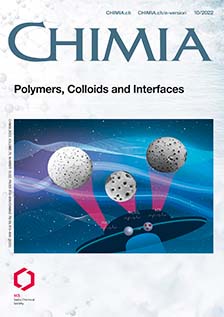Novel Insights on the Three-dimensional Shape of Microgels at Fluid Interfaces
DOI:
https://doi.org/10.2533/chimia.2022.852PMID:
38069698Keywords:
Colloidal monolayers, Liquid interface, Mechanical properties, pNIPAM microgels, Volume phase transition temperatureAbstract
Mechanically soft colloids (microgels) adsorbed at the interface between two fluids offer superior advantages over hard counterparts for a variety of applications ranging from foams/emulsion stabilization to the assembly of two-dimensional (2D) materials. Particle deformability and compressibility impart additional responses to microgel-laden interfaces that can be controlled on-demand by varying single-particle properties (e.g. crosslinking content and polymer density profile) and/or external parameters (e.g. interfacial compression and tension, temperature, oil polarity). In order to understand how single-particle softness influences the resulting material properties, a detailed quantification of the microgel’s 3D conformation when confined at the fluid interface is of utmost importance. This article describes how different methodologies can be used to visualize, and in some case quantify, the conformation of adsorbed microgels, putting particular emphasis on the multiple advantages offered by in situ atomic force microscopy imaging at the fluid interface. The influence of the internal particle architecture, as well as that of temperature, interfacial tension and solubility in the organic phase, will be discussed. Finally, some perspectives on how softness can be exploited to tune the structural and mechanical properties of microgel monolayers will be provided.
Funding data
-
Horizon 2020
Grant numbers 888076
Downloads
Published
Issue
Section
License
Copyright (c) 2022 Jacopo Vialetto

This work is licensed under a Creative Commons Attribution 4.0 International License.







